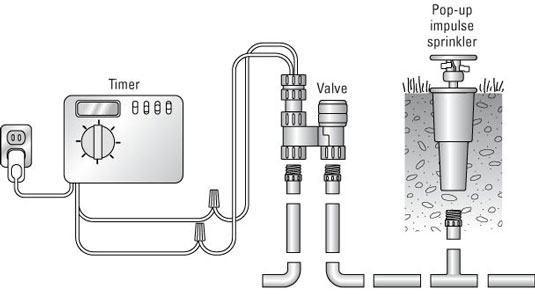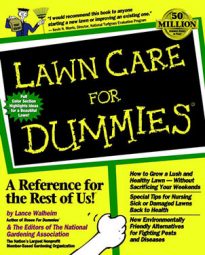The basic components of your lawn irrigation system are control valves, pipes, pipe fittings, risers, sprinkler heads, and controllers. You need to know these components and what each does, whether you’re installing the system yourself or hiring a professional:

Control valves: Control valves regulate the flow of water from the main source through the pipes and on to the sprinkler heads. Control valves, in turn, connect to the controller, or timer, that automatically opens and shuts the control valves. Most irrigation systems consist of a series of circuits (groups of sprinklers), each regulated by a control valve.
You need this setup because a typical home doesn’t have enough water pressure to water the entire lawn and service the house all at the same time. The control valves operate different circuits at different times, keeping water pressure at a steady rate. Control valves also have vacuum breakers, or antisiphon valves, that prevent back-flow of water into the main line. Backflow-prevention devices are required by law in most areas.
Pipes: Polyvinyl chloride (PVC) is the most common material used to make pipes. Pipe is usually 10 to 20 feet long and is often 3/4 inch or 1 inch in diameter, the same size as that used in the house’s service line.
PVC pipes have a flared end and a standard end. The flared end fits over the standard end when connecting the pipes with solvent.
Pipe fittings: Fittings can make your pipes turn corners, go up or down to avoid obstacles, or connect PVC to copper or galvanized pipe, for example. Fittings either screw together or need to be connected with PVC glue.
Risers: Risers are vertical pieces of pipe that connect underground pipe to the various sprinkler heads. Risers are rigid or flexible and designed for use at different heights to conform to different sprinkler-head functions.
Sprinkler heads: Sprinkler heads throw or spray the water over your lawn. Most heads are set in recessed collars. When the water gets turned on at the source, the water pressure causes the heads to pop up and spray. The heads can be plastic or brass or a combination.
You can adjust or adapt lawn sprinklers to spray different patterns, from a full 360 degrees to 180 degrees to only 90 degrees and to full or partial circles. Other types of heads water long, narrow areas.
Controllers: The controller is really the timer system, which tells the control valves when to open and close. Controllers are usually solid-state with electronic components. They operate on a 24-volt circuit with 18-gauge, jacketed electrical cable that must be suitable for use underground. Controllers are safe and easy to install.
A controller really makes your life easier because it can
Water different parts of your lawn on different days and times.
Water only the lawn and not the trees and shrubs.
Water early in the morning before you get up.
Water for a short period, shut off to let the water soak in, and then water again.
Water more in hot summer weather than in cool spring weather.
Moisture sensors: Moisture sensors read how moist the soil is. The sensors usually connect to an automatic controller that is set to water everyday. If the soil is still wet, the moisture sensor short-circuits the controller and makes it skip that day. The sprinklers don’t come on until the soil is dry and water is needed.

